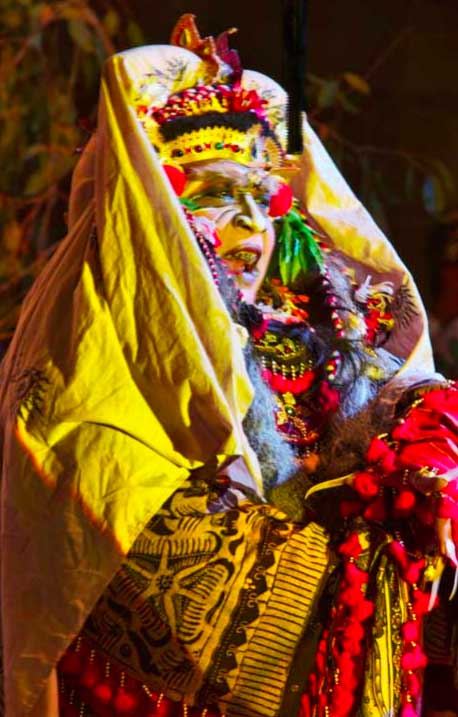Bali is a surfer’s paradise. With an incredible diversity of breaks all around the island, the perfect wave is available for all surfers, ranging from beginner to world-class pro.

LEFT HANDERS
Bali’s west coast is dominated by left reef breaks. This is where the world class surf is in Bali. The best time to surf here is in the dry winter season when the wind is blowing off shore. Some places, like Uluwatu and Canggu Beach can have excellent surf all year around, but if you are in Bali between the months of May and September, there are still plenty of breaks worth exploring.
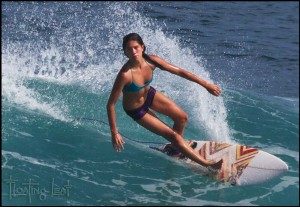
RIGHT HANDERS
Take a look at some of the right-handers on the east coast. Due to the geography of the island, the east coast just doesn’t have as much surf consistency as the west, but during the wet, summer season, you’ll find some really incredible right handers, nonetheless. If you come to Bali between the months of October and April, the spots listed below are your best bets.

Technically, Nyang Nyang and Green Bowls (some say Greenball) are not on Bali’s east coast, but are actually facing directly south, which means they get the full muscle of the unobstructed Indian Ocean with powerful swells rising up from the roaring forties. Because of the steep cliff access, strong currents and remote surfing, we highly recommend that Nyang Nyang and Green Bowls be surfed by experts only. Both breaks can get good and are pretty consistent with both left and right reef breaks. Not as good as other places on the Bukit, but the beach here is very beautiful and uncrowded, nonetheless.
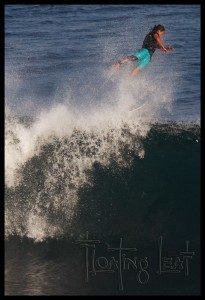
Because of its distance from land, shifty peaks and powerful waves, Nusa Dua can be a little unnerving. Not a place for the faint of heart, Nusa Dua is rarely smaller than four feet and is one of Bali’s most consistent reef breaks. It’s generally uncrowded when there’s a swell as most surfers will head someplace else, but if there’s no swell hitting the island, Nusa Dua will likely be one of the few places that has surf. Expect crowds on these days. Luckily, it’s rare that Bali is flat.
We’ll take a boat when going here. You’ll likely need a longer board and a strong leash as well because of the expected size. Clean up sets will blow through sooner or later so you’ll need to be prepared. Despite some of the hairy take offs, Nusa Dua is a great wave and a lot of fun for experienced surfers.
A very consistent, but short wave, Sri Lanka is ideal for new arrivals. Here’s a good place to warm up for some of the bigger breaks you’ll be heading to during your stay. There are fast tubes, walled sections and slow rollers, depending on the swell. So sit on the beach for a while and check it out. You will unlikely see a lot of crowds here because it’s just not one of Bali’s premier breaks, though when it’s on, you may have to fight the locals for some juicy tube rides. Catch it right, and it can be a lot of fun without the stress and intensity of Nusa Dua clean up sets.
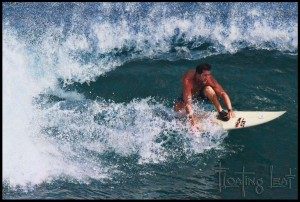
There’s almost always good surf at Serangan and it’s great for rainy season waves. The various peaks break both left and right, and with the exception of really big days, are manageable for most surfing levels. Ideal size is likely to be between 3-4 feet and are perfect for anyone looking for a fun day of surf. It can section and close out in places as the swell fills in, but we like this wave.
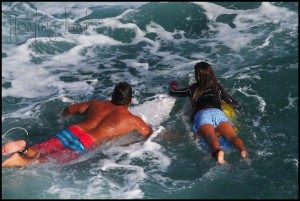
Sanur is one of our favorite towns and there is surf up and down its outer reef with various names. Hyatt Reef and Tanjungs are among the most well-known breaks with others that may or may not work on any given day.
There are a couple of things traveling surfers need to know about Sanur. First, it is very rare to catch Sanur on a good day, but when it’s good, it has been considered one of the best waves in the world. It just doesn’t work that well often enough. Secondly, the bottom is very dangerous as it breaks over very shallow, live reef. Ride the wave too far and you’ll find yourself over dry reef with no way out. Surfing at low tide is not recommended.
When the surf is too big to surf Nusa Dua, your chances of finding good waves in Sanur improve. A lot of local surf competitions are held here so it can’t be all that bad, right? When Sanur is firing, consider yourself fortunate because you’ll get some very long, juicy rides with several barrel opportunities. On a mid tide and medium to small swell, it will section and provide for several take off points. Every now and then the wave will connect and you’ll get one of those long, legendary Sanur rides. Thank the gods!
About two kilometers from shore, Hyatt Reef doesn’t get too crowded. So once again, we’ll be taking a boat. The peak can be a bit shifty and it needs a high tide and good swell to realize its full potential. Low tide can cause it to section and break on the shallow reef, but on a good day, it’s as good as anywhere. And thankfully, good days are common in Bali. We’ll want to get here early to catch some of those juicy waves before the wind hits it.

Another break along the outer reef of Sanur, Tanjungs provides both a left and right that work much like Sanur. It needs a mid to high tide and some swell. You won’t get much here on small days, but with a little size, you’re in for a real treat. Wear booties.
Not known for much surf, Ketewel can surprise you on any given day. Watch out; though most of the beaches here are sandy, huge rocks jut out up and down the coast in this area and may lurk just beneath the surface. We recommend only surfing Ketewel with a local guide who knows the area. Since this is our home break, we know all the ins and outs and can get you to several amazing and fairly unknown spots where you are likely to be among the only surfers out.
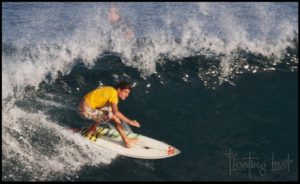
A legendary, world-class wave, Keramas can be both friendly and powerful. It generally depends on the conditions, but your trip to Bali wouldn’t be complete without an early morning sesh at Keramas. It’s difficult to predict the winds here as they seem to have a mind of their own so dawn patrol is your best bet. Many surfers leave Keramas with claims of having surfed the best waves of their life.
For many years, Keramas was a secret among locals so any session here was with few others; however, an Australian surfer recently “negotiated” through Bali’s very strict beach building code and has built a hotel smack dab in front of the takeoff zone. The hotel seems nice, but surfing here alone will likely never happen again. Fortunately, on a good day, the lineup will be spread out enough to provide everyone with their fill of surf.
Keramas has a shallow reef and a pretty fast takeoff so we recommend intermediate and expert surfers only attempt this wave. If you fall into that category, then Keramas is truly a wave to get excited about.
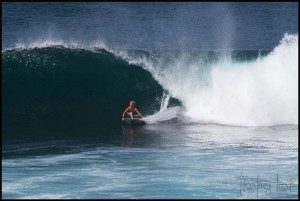
Across the open ocean from Sanur are the islands of Nusa Lembongan, Ceningan and Nusa Penida. With several breaks along the west side of the island, Nusa Lembongan can be a day trip or an over-nighter. We’ll discuss the time of year you’ll be coming to Bali and decide together if it’s a trip you would like to take. Even if there is no surf, Nusa Lembongan is a beautiful, sleepy tropical island with great diving and snorkeling. If conditions are right, however, the surf is definitely worth the trip.
PLAYGROUNDS
This wave is suitable for all levels. It’s soft and very easy to surf. Be careful of the strong currents as they can make it difficult to maintain yourself in the right take off spot when a set comes in. Otherwise, you’ll get some long lefts and a few short rights.
SHIPWRECK
Ideal at mid tide, Shipwreck is the best wave on the island. It’s a very reliable right hander that will get bigger with the tide. It’s typically a short, intense ride that can get sketchy on the inside due to the shallow reef. Again, watch the sucky current.
LACERATIONS
Here’ a shallow sharp reef which is aptly named. It can produce some excellent barrels, but don’t ride it too far as the inside can break over dry reef, especially at low tide. It’s fast, hollow and can produce some nice barrels. Experts only.
CENINGAN
The next island over has a nice break for long boarders and those who like mellow surf. It’s a nice little island and can make for a beautiful vacation with the family.
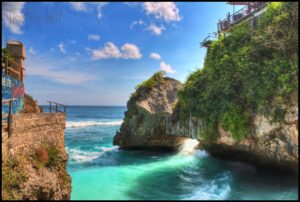
Anyone who has considered coming to Bali knows about Uluwatu and its tricky and potentially dangerous entrance point. Uluwatu is a world-class left reef break with rides as long as 300 meters on good days and 150 meters on an average day. It almost always has waves and should be on every experienced surfer’s bucket list. We recommend that beginners do not surf Uluwatu and that even experienced surfers be careful negotiating the entrance and exit point over the sharp reef and through the cave.
Uluwatu has several peaks and is probably Bali’s most crowded wave, though we’ve caught it at times with only a handful of surfers. The Peak is the most consistent wave at Uluwatu and is just to the left of the cave. When it’s small it can close out. When it’s big, it can be pretty dicey, but oh those barrel rides!
Entering the surfing area of Uluwatu from the parking lot, you will be on the cliff looking out onto this stunning vista. The cave is below and to the left. Make your way down the path to the left, past the shops, surfboard repair places and cafes and the path will switchback to the right and you will see some steep stairs eventually leading to the cave.
Racetracks is to the right of the cave and is a long, fast wave. Racetracks is best at mid to low tide. Also at mid to low tide is the Inside Corner, which can produce some hallow tubes near the end. The Outside Corner can get big and will require your gun when it does. It works best with a strong swell and can wall up – this one’s for experienced surfers only. Finally, Temple is an incredible tube when it works, which is rare. Temple has two waves, actually, Outside Temple and Bombies. It breaks over shallow rocks and reef so this is another one for experts only.
Getting out of the water and back through the cave can be tricky. You want to be careful not to over paddle as the current can push you past the cave. If this happens you’ll likely have to paddle back out toward the line up and try again. Depending on the tide, the reef can be more dangerous on your way in than it was on your way out so be careful. There is no easy way to do this.
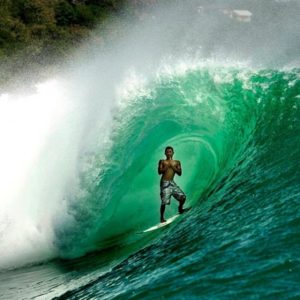
Probably the most dangerous wave in Bali, Padang Padang is a super fast, powerful wave. When it’s pumping, it’s Bali’s version of Pipeline. You’ll have to prove to us that you know what you’re doing before we take you here. The wave tubes early and then it really starts to cook. On a good day, you can get some very long rides at Padang Padang. On a small day, it’s actually not that bad at mid to high tides. It may be tempting to ride the wave too far. Don’t do it. There’s a very shallow and sharp reef on the inside section.
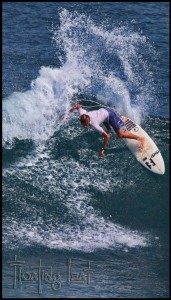
Named Impossibles for a very good reason. This is a very fast wave and can be difficult to make. You’ve got to get it and go. Smaller swells can section, but when the swell is good, it can produce some juicy hollow tubes and the wave can be ridden left for several hundred meters. This super fast wave will eventually race past you. It doesn’t get very crowded because the takeoff points are spread across a wide area. Yet another wave we recommend for experts only.
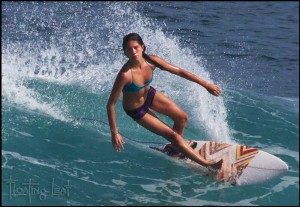
Short and Sweet. Another left reef break. Bingin is a short wave, but it’s almost difficult to not get a barrel ride here. The only thing in your way may be about 20 to 30 other surfers trying to get the same hollow tube ride as you. Did we say Uluwatu was crowded? The locals here surf like they drive so expect them to drop in on you, but it’s not malicious, it’s just their way. Be patient and forgiving at Bingin. Best at mid to low tide and suitable for good, tolerant surfers.
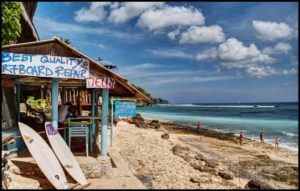
Finally! A wave for less experienced surfers. Dreamland is a beautiful Bali beach and a nice soft, fat wave that breaks both left and right. I would not recommend it for anyone who hasn’t surfed before, but if you’ve got even a little surfing experience, Dreamland can be a lot of fun. It has been said that the rides can get long. We’re not sure who said it because the wave always seems to break and then flatten out over deeper water. If you surf here, keep in mind you’ll be surfing with a lot of beginners so be patient. Feel free to help out.
Would be a great wave in most places in the world, but in a land of world-class surf, fickle Balangan needs the right swell and the right conditions to measure up to its neighbors such as Uluwatu and Impossibles. Mid tide waves are the best, but low tide can produce some hollow tubes. Overall, a fun left for all, but beginner surfers.
There’s both a left and right reef that breaks off the end of the airport, which extends out into the sea. It’s far enough away that we’ll take a boat to get to it, but that also means fewer crowds than some of the other breaks. Both breaks work best with bigger swells and are makeable for surfers at all levels. A good place for the intermediate surfer.
Another boat ride unless you want to paddle 20 minutes to the peak. If you’re with us, you’re taking a boat. Kuta Reef is a fun left reef break that can have a ledgey take off on really big swells, but otherwise is not too daunting. Sections tend to slow down at points, and then go fast again, but overall this wave is a lot of fun. It will get crowded during the week and even more so on the weekends.
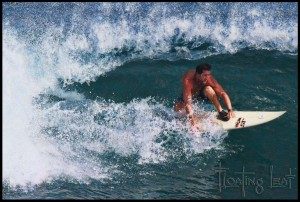
Suitable for all levels, even beginners. You’ll find a lot of surf lessons taking place on Kuta Beach as it’s an above average, safe wave with a sandy bottom. On a big swell, Kuta can have some fast sections and close out. In fact, it can close out even on small swells. You’ll find crowds here, but they tend to congregate at certain peaks and there’s usually other peaks you can find that are less crowded.
Kuta Beach can surprise you. A beach break amongst so many barreling reefs might not seem appealing, but there are a lot of good waves to be had here. This is a good place to start your surf vacation and get introduced to Bali surfing.
Almost always a foot or two bigger, Legian can be a good alternative to Kuta Beach and is suitable for all levels except beginners. Watch out for the rip currents and crowds. Legian has a tendency to close out on low tides and may close out on high tide as well if there’s a really big swell. Waves at high tide can pack a serious punch. There are different peaks at Legian that perform differently; Padama, Blue Ocean and Gado-Gado all have their possibilities. Watch from the beach and see what’s working.
Berawa is a sandy left beach break with decent tube rides for surfers at any level. Rides are average length for the region, but can be fun and fast. It’s also a very consistent wave, which means it can get crowded.
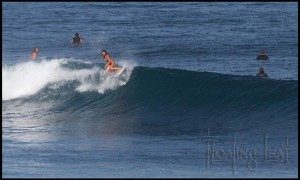
With both lefts and rights, Canggu is a great place to surf and has something for every surfing level. Echo Beach, the main area, has soft, rolling waves for less experienced surfers as well as fast, barrel rides for the hot dogs.
Canggu is a nice, laid back neighborhood and many expat families reside here. This would be a good place to surf while your non-surfing partner goes to check out the Tanah Lot temple, about 20 minutes further up the road.
The beach here faces more south than Kuta so it can deliver some power, even as it appears to be mellow from your vantage point on the beach. It’s best to come here early and get it before the wind begins blowing side shore and starts messing things up. We’ll be sure to get you up nice and early if you want to surf Canggu.
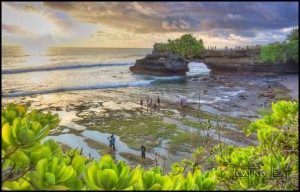
It is known for its beautiful sacred temple and is visited by tourists from all over the world. The wave at Tanah Lot is easy enough for most surfers, but negotiating the rocks can be a little tricky. You may want to purchase a ticket for the temple for an easier entrance to the surf. Because of the limited access, you won’t find a big crowd.
There’s something surreal about surfing before the serene temple, especially if you surf at sunset. You’ll be engaged in one of the most spiritual physical activities there is before a powerful spiritual temple. Note: Do not undress in front of the temple or anywhere near it. Tanah Lot is a sacred place among the locals so respect the people and their gods.
The break is generally a left. There are peaks to the north and south of the temple, but the southern peak is the best in our opinion. It’s ideal at mid to low tide and can work on even a small swell.
A Balian is a kind of Balinese healer or shaman. We’re not sure if there is any correlation between the name and the beach, but Balian has some serious potential as it’s usually bigger here than elsewhere on this side of the island. It’s not as consistent and it can get blown out by the trade winds by 9:00 in the morning. Balian is for surfers who don’t mind getting up early. It has both lefts and rights, but the lefts have better tubes and longer rides. This is a good place to get away from the crowds and the craziness of Kuta and Legian. It won’t have the quality of the Bukit and the current can be very powerful due to the river mouth, but it always seems worth it to come here.
A long left hander with fat slow waves makes Medewi an ideal point break for long boarders and those who want a workable, easy-to-catch wave. Its long rides and consistent wave can make it a lot of fun. We don’t recommend that absolute beginners come here, but it’s generally safe for everyone else.
SECRET SPOTS
Of course we’re not going to publish all the secret or lesser known surf spots we know about or they would no longer be secret. Makes sense, right? There are fewer and fewer of them left on Bali, but our local connection has us dialed into a few of them that we will share with you when you get here. You just need to be blind-folded, hog tied and sworn to secrecy by a blood oath (kidding, of course).
Between Balian and Medewi you’ll find several places that are not published in any guide and work well under particular conditions. It’s a good opportunity to go exploring on your own if you have the time. If you’re only in Bali for a couple weeks, we suggest sticking to the known surf spots as a search for secret places can waste a lot of time when you could otherwise be in the water catching some of Bali’s incredible barrel ride


